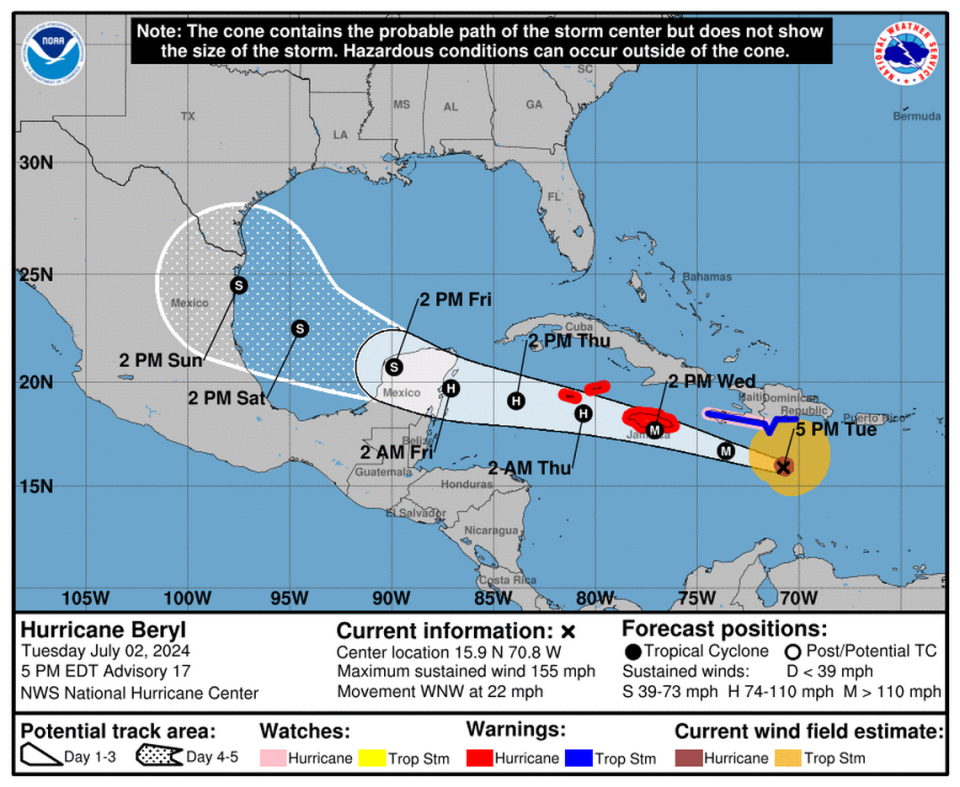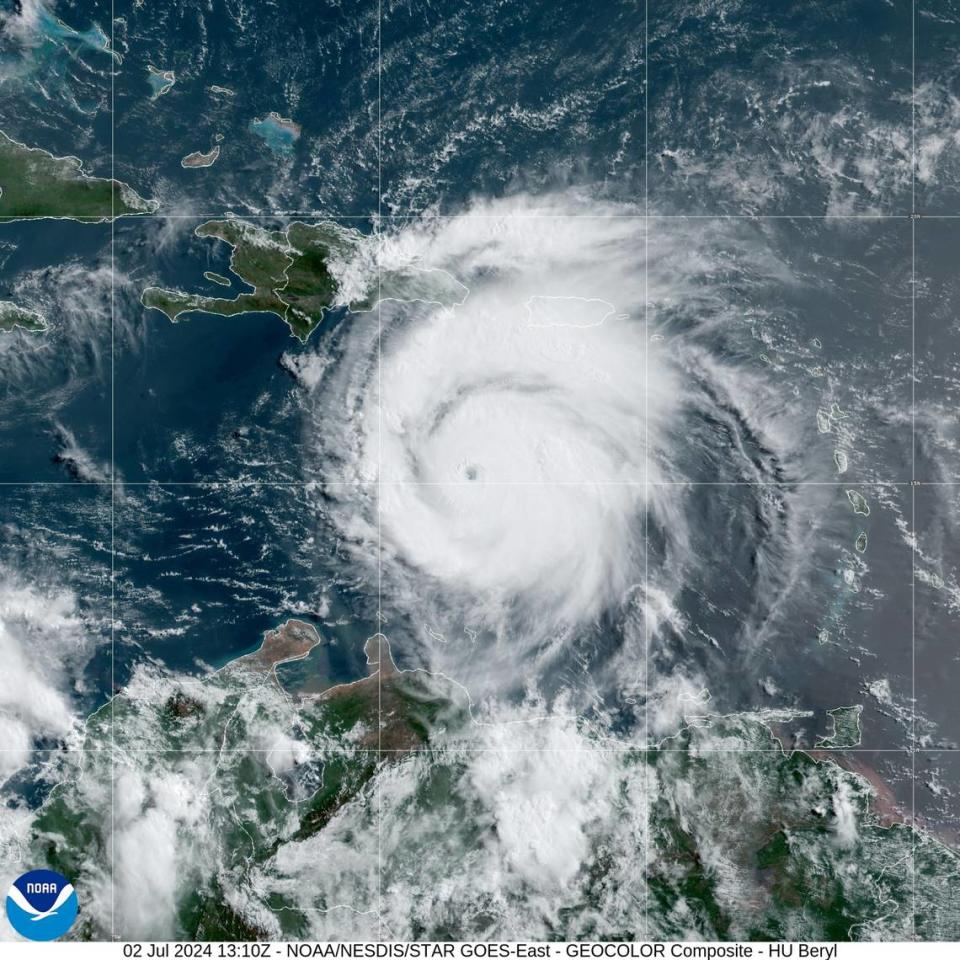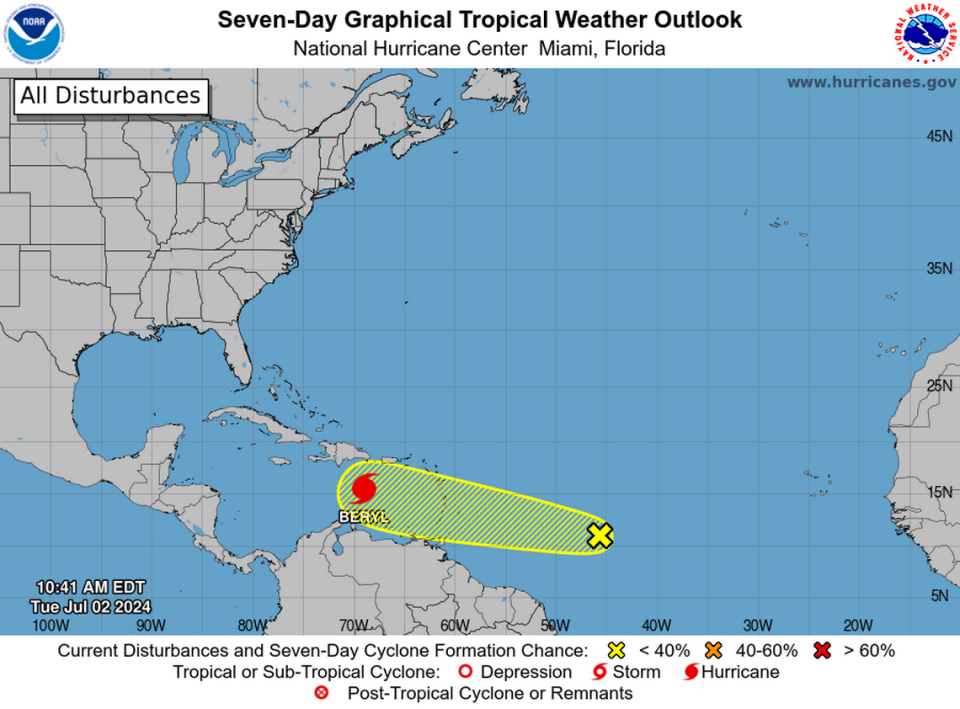Beryl becomes a Cat 5, the earliest in Atlantic history. Storm’s next target is Jamaica
A powerful hurricane pounded the Caribbean Islands, smashing decades-old records for strength and intensity and leaving a trail of destruction across the small island communities before it barreled west through the Caribbean Sea.
Hurricane Beryl will next reach Jamaica on Wednesday, forecasters with the National Hurricane Center said.
Its eye struck Grenada’s Carriacou Island Monday morning with 150 mph winds. Tuesday morning, the National Hurricane Center said the storm’s maximum sustained winds had reached 165 mph, making Beryl the earliest Atlantic basin Category 5 storm on record.
“This is a very dangerous situation,” National Hurricane Center forecaster Eric Blake wrote in a Monday morning discussion.

The hurricane weakened slightly Tuesday evening, the National Hurricane Center said, but was still a dangerous storm. The NHC estimated it would reach the Cayman Islands on Wednesday or Thursday and near Mexico’s Yucatan Peninsula Thursday night.
Forecasters expect it will weaken through the week but still be a hurricane by the time it reaches the Yucatan Peninsula.
It is the strongest hurricane to ever hit the Atlantic this early in the season, forecasters said, and the first storm in more than 90 years to reach so far east in June. Forecasters said on average, the first hurricane of a season comes around August 11.
And Beryl is one of three named storms already this season: Tropical Storm Chris hit the southeastern Mexican coastline on Monday and Tropical Storm Alberto drowned the same region in heavy rainfall last month.

Will Hurricane Beryl reach the Gulf Coast?
Forecasters have been warning for days it is too soon to tell if Beryl will hit any part of the U.S., including Mississippi.
No direct or indirect impacts are expected in South Mississippi this week. It’s track appears more set on parts of the Mexico and Texas coasts, but forecasters said little about the storm was certain after it passes through the Yucatan Peninsula.
Addressing worried Gulf Coast residents on social media on Sunday, Former National Hurricane Center Director Rick Knabb said it was “not time to overreact.”
“Too many track, intensity and size variables over next week plus,” Knabb wrote. “But it’s not time to ignore the situation either.” He said residents across the Gulf South should make only preliminary preparations and help vulnerable residents decide on a plan.
For those asking if #Beryl will strike their town on Gulf coast, it’s too soon to know and not time to overreact. Too many track, intensity and size variables over next week plus. But it’s not time to ignore the situation either. Prelim preps only, help vulnerable make a plan.
— Dr. Rick Knabb (@DrRickKnabb) June 30, 2024
Forecasters have avoided predictions about the ultimate fate of the storm in part because it is hard to tell how changes in Caribbean wind speed and direction will impact Beryl as it moves through the area, according to The Weather Channel.
Those speed and direction changes, called wind shear, are usually strong enough in June to fight the force of tropical systems approaching from the east.
An increase in wind shear from the west could force Beryl to weaken over the central Caribbean, the National Hurricane Center said Monday morning. Latest forecasts show a weaker storm in the western Caribbean, but it is unclear how much the shifting winds could slow Beryl down through the week.
“There remains considerable spread in the intensity guidance when Beryl emerges over the Gulf of Mexico,” National Hurricane Center forecaster Jack Beven wrote in a Tuesday evening discussion, “although there is somewhat better agreement that the cyclone will intensify some while crossing the Gulf.”
#Hurricane #Beryl is now a Category 4 hurricane with max winds of 130 mph - the earliest calendar year Atlantic Category 4 hurricane on record. Old Atlantic record for earliest Category 4 hurricane was Hurricane Dennis on July 8, 2005 at 0UTC. pic.twitter.com/JAG4QGLgBh
— Philip Klotzbach (@philklotzbach) June 30, 2024
Beryl is latest storm in already active hurricane season
Beryl is the first hurricane and second named system this year. Tropical Storm Chris formed late Sunday and its remnants dissipated heavy rain over eastern Mexico Monday morning, forecasters said. That system came just weeks after Tropical Storm Alberto pounded the southeastern Mexican coast in June. Alberto also sent storm surge through Texas and even brought minor flooding to low-lying areas of the Mississippi Coast.
Forecasters are also tracking a disturbance deep in the Atlantic that has a low chance chance of development in the next week.
The three named storms strengthened in a season forecasters have already warned will be extraordinary. Fueled by record warm waters and calmer Atlantic winds, Beryl and Alberto became the first of 17 to 25 named storms forecasters predict will form before the season’s end on November 30.
Most hurricane seasons have just 14 named storms.

This is a developing story. Check back for updates.


